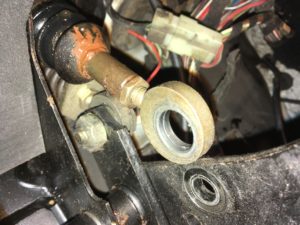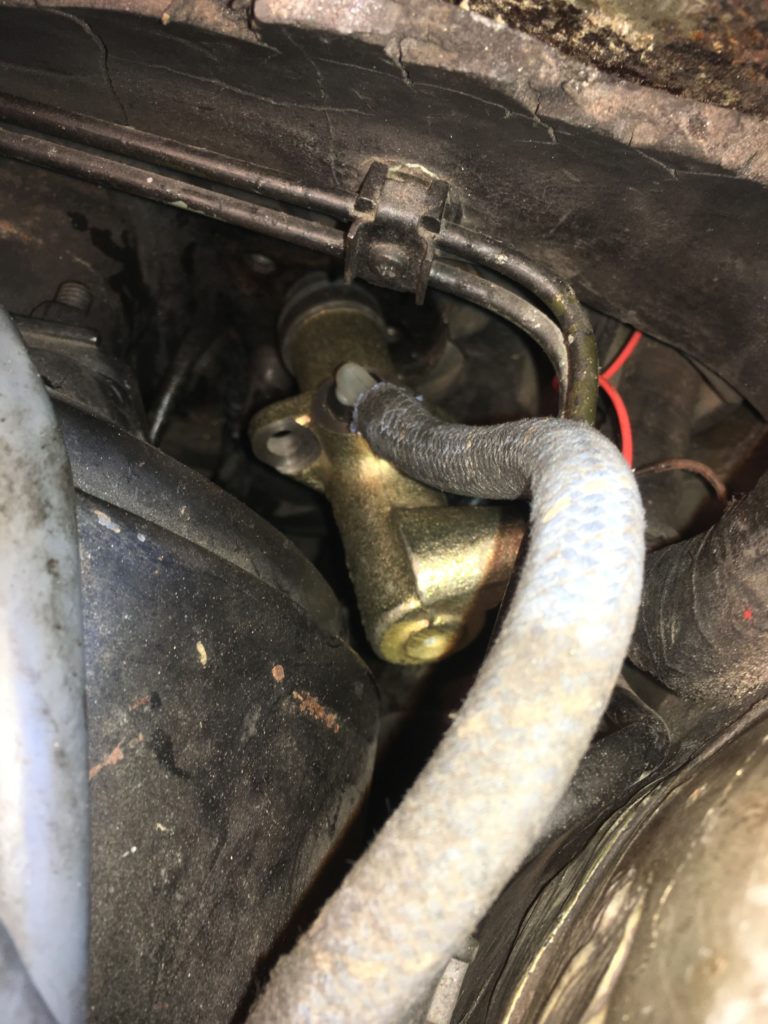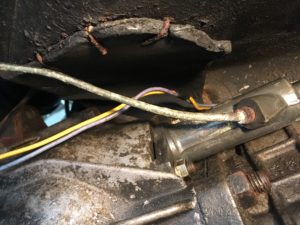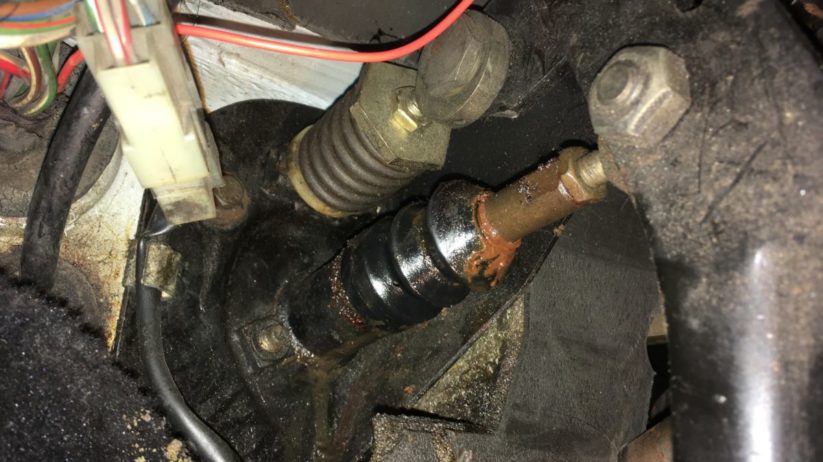I ended last week’s piece on a cocky note, literally taunting the Automotive Powers That Be by saying that I expected to find no problems while sorting out Sharkey the ’79 Euro 635CSi for the 2,000-mile round trip to the Vintage in Asheville.
You don’t do that sort of thing without consequences.
I found the potential show-stopper in a funny way. As you may recall, I’d retrofitted air-conditioning into Sharkey last fall, but by the time I charged it with refrigerant, the outside temperatures were cool enough that I couldn’t really tell how well the a/c was working. So I looked forward to the first 85-degree day in Boston so that I could drive the car and see how well the a/c worked.
And the answer was… pretty damned well, except that there was clearly hot air flowing onto my left ankle from some source of heat intrusion into the cabin. I stuck my head under the steering wheel and immediately found the source: The grommet surrounding a big section of the wiring harness was completely pushed out. With some groping and prodding from both the cabin side and the engine-compartment side, I was able to re-seat it.
But while my head was on the driver’s-side floor and I was looking up, I saw something unexpected: a leaking clutch master cylinder. The rubber boot was not only wet, a concoction of hydraulic fluid and rust was oozing out of the end. Not good.
Now, this leakage was asymptomatic; I had been having zero issues with Sharkey’s clutch. But considering what I went through with Louie, my ’72 tii (whose clutch master cylinder failed at the gas station where I was fueling up before pulling onto the Interstate to embark on the first leg of his thousand-mile drive home), when you find something like this, you’re really tempting fate—and not in the joking way that I was last week—if you don’t replace it.
The first thing I needed to do was procure a replacement, and fast, since I found the problem on Thursday evening and I was slated to leave for the Vintage the following Wednesday morning. The clutch master cylinder for an early E24 like Sharkey is a widely-available part, sold by both BMW and the aftermarket. The website of FCP Euro in Connecticut said that they had an aftermarket one in stock. I seriously considered driving down there to get it in my hot little hands, but then I found a new old stock ATE part on eBay in Miami for the cost of an aftermarket unit, sold by someone who advertised two-day shipping. I messaged him, verified that he’d get it out ASAP, bought it, then waited for it to arrive. While I was waiting, I did not pull the old one out, just in case the part arrived late—or did not arrive at all—and I had no choice but to drive on the old one.

Detaching the clutch master from the clutch pedal consists of using a 19mm wrench and a 17mm socket to undo one bolt and nut. Simple.
The new part arrived at noon on Monday. With it in hand, I tore into removal of the leaky one. I did the trivial part first: unbolting the master from the clutch pedal. That left unbolting the master from the firewall. For several reasons, this was much easier than it was last year with Louie; first, since, on a 2002, the pedals come up from the bottom of the floor, the clutch master cylinder is fairly low, requiring access from beneath the car. In contrast, on the E24, the pedals are suspended from above, so the clutch master is high up, allowing you to reach it from under the hood.
Second, a 2002’s clutch master is attached to the firewall with nuts and bolts, which means that you need to immobilize the bolt head while you turn the nut, or vice-versa. This is best done with the aid of another person, although it’s possible to clamp a Vise Grip onto the nut and loosen the bolt yourself. Sharkey’s clutch master instead used bolts that threaded from the engine compartment side directly into a plate in the firewall (e.g., no nuts), eliminating the need for a helper.

The clutch master is right there, easily visible from under the hood, but the bolts are difficult to access.
However, even with those advantages, it was not trivial to get the old clutch master out. The bolts holding in the master could be easily seen from the top of the engine compartment, but getting a wrench or a socket on them and loosening them wasn’t easy due to clearance issues created by the proximity of the big brake booster.
It was one of those times I was grateful for a nearly 40-year accumulation of tools. I have a little ¼-inch breaker bar. Using that and a 13-mm socket allowed me to get enough torque on the bolts to crack them. I then had to do the business of loosening the bolt an eighth of a turn at a time, and flipping the socket over so I could get the right starting point for the next eighth of a turn. Once the bolts were loose enough, I switched to using a nut-driver with a flexible extension that bent the 90 degrees required to reach the head of the bolts.

I used a flexible extension on a nut-driver to loosen the already-cracked bolts.
I then connected the reservoir hose to the new master, lowered it into position, and installed it.

I attached the reservoir hose before lowering the clutch master into position.
Once the new master was installed, I just needed to bleed it. I have a Motive power bleeder that I use for this. I put about a quart of fluid in the Motive, attached its cap to the brake reservoir, pressurized it, and then cracked open the bleed nipple on the clutch slave and caught the bled fluid with a hose running into a bottle; I ran quite a bit of fluid through it before the bubbles stopped. I then pumped the clutch pedal, and it felt good and hard. I patted myself on the back for detecting and forestalling failure, undid the Motive, and lowered the car from where it was up on the lift for bleeding.
The next morning, there was nothing left to do but pack the car with tools and parts. To do that, I needed to pull the car forward from the spot where the lift was. I got in it and depressed the clutch—
And the pedal sank right to the floor.
Oh, dear.

The clutch slave looked recent. And how about the size of those wires to the reverse switch?
One thought occurred to me: I was an idiot for replacing the clutch master cylinder but not also spending the short money and doing the clutch slave at the same time. In my defense, the slave looked recent (though the metal line looked old, and the gauge of the wires to the reverse switch was probably sufficient to power landing lights at an airport runway). The slave, however, turned out to be a red herring; I can’t say exactly why the clutch pedal went to the floor, but with a few pumps, it got hard again—and stayed that way. After I packed the car, I used it to run errands, and did not have any further problems with the clutch.
I write this from the Clarion Inn, the event hotel for the Vintage. So Sharkey and I did make it down here.
But not without drama. And that, my friends, will be the subject of next week’s piece.—Rob Siegel
Rob’s new book, Just Needs a Recharge: The Hack MechanicTM Guide to Vintage Air Conditioning, is available here on Amazon. Or you can order personally inscribed copies through Rob’s website: www.robsiegel.com.





















